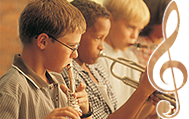Limericks Rhythm Lesson
Submitted by Louise Eddington, Muncie, Indiana
Idea posted 2004-12-17
After exploring some fun limericks for their form (i.e., AABBA, rhyme structure, humor, etc.), my students learned the three types of rhythms present in limericks: the rhythm of the words, the underlying steady beat, and the little "ta-da" that can be added at the end of each A line. The class spoke the selected limerick while using body percussion to do either: a controlled soft clap, a knee patsch with both hands, or a finger snap in air (one hand and then other) as designated by the teacher. Then, the class was divided into a three-way split so that all three rhythms were present while the class was still speaking the verse. This then led to untuned percussion of the limerick. We found that word rhythms worked well on woods (i.e., wood blocks, rhythm sticks, etc.), steady beats worked best on hand drums, and the little "ta-da" at the end of the A phrases worked well with triangles or finger cymbals. We rotated the three groups until all children had been on all three parts.
This activity can transfer to barred percussion set in C pentatonic. Steady beat can be a bordun on the metallophones. The "Ta-da" can be on glocks (low G and then high G). For the word rhythm, I had four xylophone players with hard mallets; each played an improvised melody for the word rhythm of their phrase only. (The two short B phrases were counted as one.) It really came out well!
